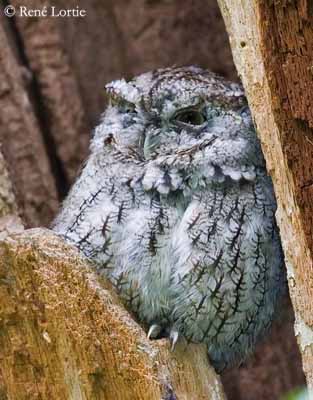
Eastern Screech Owl
Megascops asio
Strigiforme Order – Strigidae Family
BIOMETRICS:
Length: 16-25 cm
Wingspan: 48-61 cm
Weight: 121-244 g
LONGEVITY: Up to 14 years
DESCRIPTION:
Eastern Screech-Owl is a small owl. We can observe two distinct morphs: grey phase and reddish-brown phase.
Adult grey morph has dusky white facial disks, finely mottled with grey-brown and bordered by black line. Eyes are yellow. Bill is grey-green, and there are bristly feathers around the base. Underparts are grey-brown, with fine grey vertical streaks, but also bars and spots. Wings and tail are barred. Short legs and large toes are feathered.
Fr: Petit-duc maculé
All : Ostkreischeule
Esp : Autillo Yanqui
Ital : Assiolo americano orientale
Nd : Schreenwuil
Sd : östlig skrikdvärguv
Photographs by René Lortie
His website : http://rlortie.ca/
Text by Nicole Bouglouan
Sources:
HANDBOOK OF THE BIRDS OF THE WORLD Vol 5 by Josep del Hoyo-Andrew Elliott-Jordi Sargatal - Lynx Edicions - ISBN: 8487334253
FIELD GUIDE TO THE BIRDS OF NORTH AMERICA - National Geographic Society - ISBN: 0792274512
All About Birds (Cornell Lab of Ornithology)
Animal Diversity Web (University of Michigan Museum of Zoology)
Wikipedia (Wikipedia, The Free Encyclopedia)
What Bird-The ultimate Bird Guide (Mitchell Waite)

Adult reddish-brown phase is similar, but cinnamon replaces grey colour. Face is light cinnamon, with white supercilium and lores. This reddish morph is only the third of the population.
Both sexes are similar, with female larger than male.
Juvenile grey morph has indistinct stripes and bars more patterned, and a lot of feathers tipped with white.
Juvenile reddish-brown morph has distinctly reddish colour overall, and pattern less distinct than adults.
VOICE: SOUNDS BY XENO-CANTO
Eastern Screech-Owl has two typical calls. A series of quavering whistles, descending in pitch, used in territory defence, and a long single trill, on only one pitch, used when they arrive at nest with food, to call nestlings when fledge, and during courtship.
Nestlings and female utter soft calls within the nest cavity.
We can hear hoots, rasps, barks and screeches, and these calls indicate different degrees of alarm.
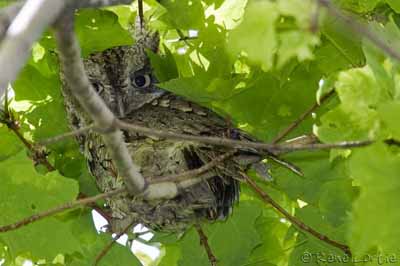
HABITAT:
Eastern Screech-Owl lives in habitat with trees to nest, groves, forests, swamps and orchards. It is common in rural and suburban areas.
RANGE:
Eastern Screech-Owl is resident in the half eastern of North America.
BEHAVIOUR:
When it is threatened, Eastern Screech-Owl stretches its body and tightens its feathers, in order to look like a branch, resembling trunk tree. It uses alarm calls, and may attack potential predators approaching their young. They are vigilant near the nest cavity.
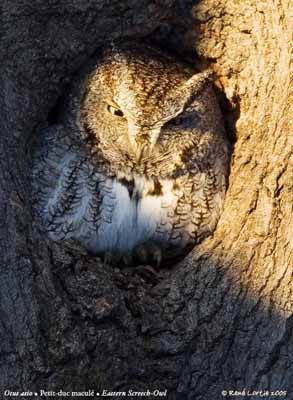
Eastern Screech-Owl probably hunts by sight and hearing. They are nocturnal birds, and they may catch hidden preys. They use the “wait and see” tactic, sitting on a tree branch and waiting for a prey. They cache prey in the nest for later consumption. They hop and walk on the ground when chasing prey. It also searches for prey while in flight. It catches prey diving quickly and it seizes it in its talons. It may capture insects while flying. It swallows whole preys, but it carries larger in the bill to its perch and tears it into pieces.
It ejects medium-sized pellets, composed of feathers, fur and bones.
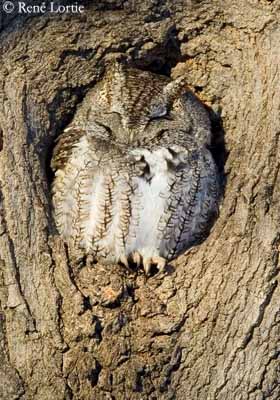
Eastern Screech-Owl is resident, and pair may use the same nest all year round. Females may re-use same nest-site. During winter, mates share the same winter nest. They usually form pair bonds for life, but sometimes, males may mate with more than one female.
Male and female crouch and trill when the other mate approaches. They perform spectacular courtship displays. Little by little, male approaches female, calling from branches. When they are close to each other, male bobs and swivels its head, bobbing entire body, and slowly winks one eye at female. It may intensify its displays if female doesn’t respond. But if she accepts, they touch their bills and preen each other. They mate for life, and both two morphs may mate together.
FLIGHT:
Eastern Screech-Owl has rapid flight with steady wing beats. It may fly with erratic movements when crossing wooded areas. It rarely glides or hovers.
REPRODUCTION:
Eastern Screech-Owl’s nest is located in tree cavities, enlarged natural cavities, or old Woodpecker holes, and sometimes nest-boxes. Any material is added.
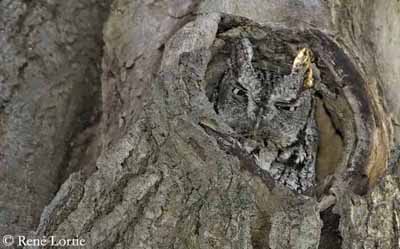
Female lays 2 to 8 eggs on the floor of cavity. She lays one egg every two days. Incubation starts when the third egg is laid. It lasts about 26 to 34 days, shared by both parents, but female does more than male.
Chicks hatch altricial, and they are fed by both adults. Male brings food and female broods the chicks. She tears the food in small pieces to feed them.
Young fledge at about one month of age, and they disperse together in the autumn.
This species produces only one clutch per year, and a second if first is lost.
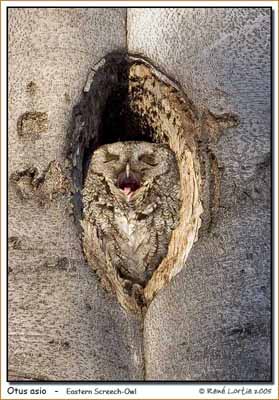
DIET:
Eastern Screech-Owl feeds mainly on small rodents and deer mice, rats, chipmunks, squirrels, bats and moles. It may catch large flying insects, many species of small songbirds, but also larger birds such as Doves and Grouses. They also consume small fishes, snakes, lizards, small turtles, frogs, and invertebrates such as snails, spiders, earthworms and scorpions.
PROTECTION/THREATS/STATUS:
Eastern Screech-Owl is widespread and locally common. They have predators, attacking as adults or juveniles, such as several species of Owls, weasels, raccoons, snakes, crows and jays.
Eastern Screech-Owl is threatened by deforestation, and loss of appropriated nesting cavities.